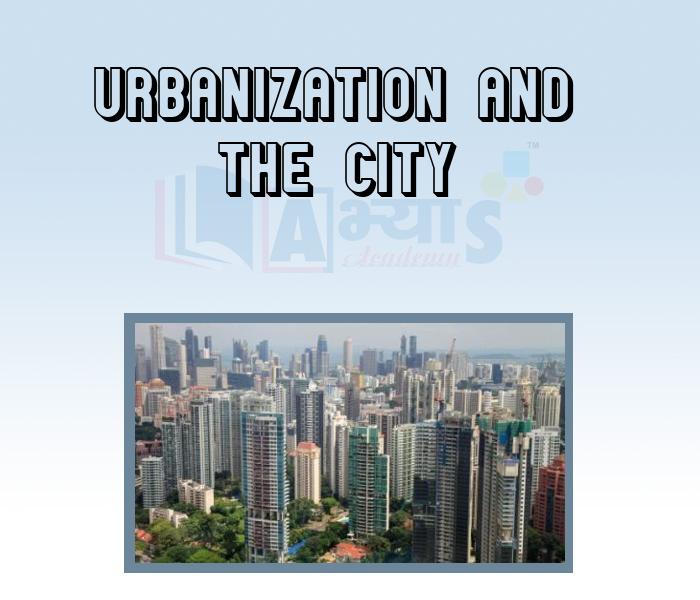Urbanization and the City












Urbanization and the City
What was special about these cities?
The Formation of Cities: Why did cities form in the first place? There is insufficient evidence to assert what conditions gave rise to the first cities, but some theorists have speculated on what they consider pre-conditions and basic mechanisms that could explain the rise of cities. Agriculture is believed to be a pre-requisite for cities, which help preserve surplus production and create economies of scale.
The conventional view holds that cities first formed after the Neolithic Revolution, with the spread of agriculture. The advent of farming encouraged hunter-gatherers to abandon nomadic lifestyles and settle near others who lived by agricultural production. Agriculture yielded more food, which made denser human populations possible, thereby supporting city development. Farming led to dense, settled populations, and food surpluses that required storage and could facilitate trade. These conditions seem to be important prerequisites for city life. Many theorists hypothesize that agriculture preceded the development of cities and led to their growth.
A good environment and strong social organization are two necessities for the formation of a successful city. A good environment includes clean water and a favorable climate for growing crops and agriculture. A strong sense of social organization helps a newly formed city work together in times of need, and it allows people to develop various functions to assist in the future development of the city (for example, farmer or merchant). Without these two common features, as well as advanced agricultural technology, a newly formed city is not likely to succeed.
Urbanization and cities: A city is a large and densely populated area. Cities are also known as urban area. When more and more people start moving from villages to towns and cities, the process is called urbanization. Urbanization is one of the key features of civilization. In cities, people have occupations other than farming. There are traders, jewellery makers, writers, thinkers, and artists. Cities usually have well-developed public facilities like roads, a drainage system, public halls, and granaries.
Many of these cities were divided into two or more parts. Usually, the part to the west was smaller but higher. Archaeologists describe this as the citadel. Generally, the part to the east was larger but lower. This is called the lower town. Very often walls of baked brick were built around each part. The bricks were so well made that they have lasted for thousands of years. The bricks were laid in an interlocking pattern and that made the walls strong. In some cities, special buildings were constructed on the citadel. For example, in Mohenjo-Daro, a very special tank, which archaeologists call the great bath, was built in this area, this was lined with bricks, coated with plaster, and made water- tight with a layer of natural tar. There were steps leading down to it from two sides, while there were rooms on all sides, water was probably brought in from a well and drained out after use. Perhaps important people took a dip in this tank on special occasions.
Students / Parents Reviews [10]
Abhyas is a complete education Institute. Here extreme care is taken by teacher with the help of regular exam. Extra classes also conducted by the institute, if the student is weak.

Om Umang
10thIt was a good experience with Abhyas Academy. I even faced problems in starting but slowly and steadily overcomed. Especially reasoning classes helped me a lot.

Cheshta
10thAbout Abhyas metholodology the teachers are very nice and hardworking toward students.The Centre Head Mrs Anu Sethi is also a brilliant teacher.Abhyas has taught me how to overcome problems and has always taken my doubts and suppoeted me.

Shreya Shrivastava
8thAbhyas Methodology is very good. It is based on according to student and each child manages accordingly to its properly. Methodology has improved the abilities of students to shine them in future.

Manish Kumar
10thIt has a great methodology. Students here can get analysis to their test quickly.We can learn easily through PPTs and the testing methods are good. We know that where we have to practice

Barkha Arora
10thOne of the best institutes to develope a child interest in studies.Provides SST and English knowledge also unlike other institutes. Teachers are co operative and friendly online tests andPPT develope practical knowledge also.

Aman Kumar Shrivastava
10thMy experience was very good with Abhyas academy. I am studying here from 6th class and I am satisfied by its results in my life. I improved a lot here ahead of school syllabus.

Ayan Ghosh
8thIt was good as the experience because as we had come here we had been improved in a such envirnment created here.Extra is taught which is beneficial for future.

Eshan Arora
8thI have spent a wonderful time in Abhyas academy. It has made my reasoning more apt, English more stronger and Maths an interesting subject for me. It has given me a habbit of self studying

Yatharthi Sharma
10thMy experience with Abhyas is very good. I have learnt many things here like vedic maths and reasoning also. Teachers here first take our doubts and then there are assignments to verify our weak points.
